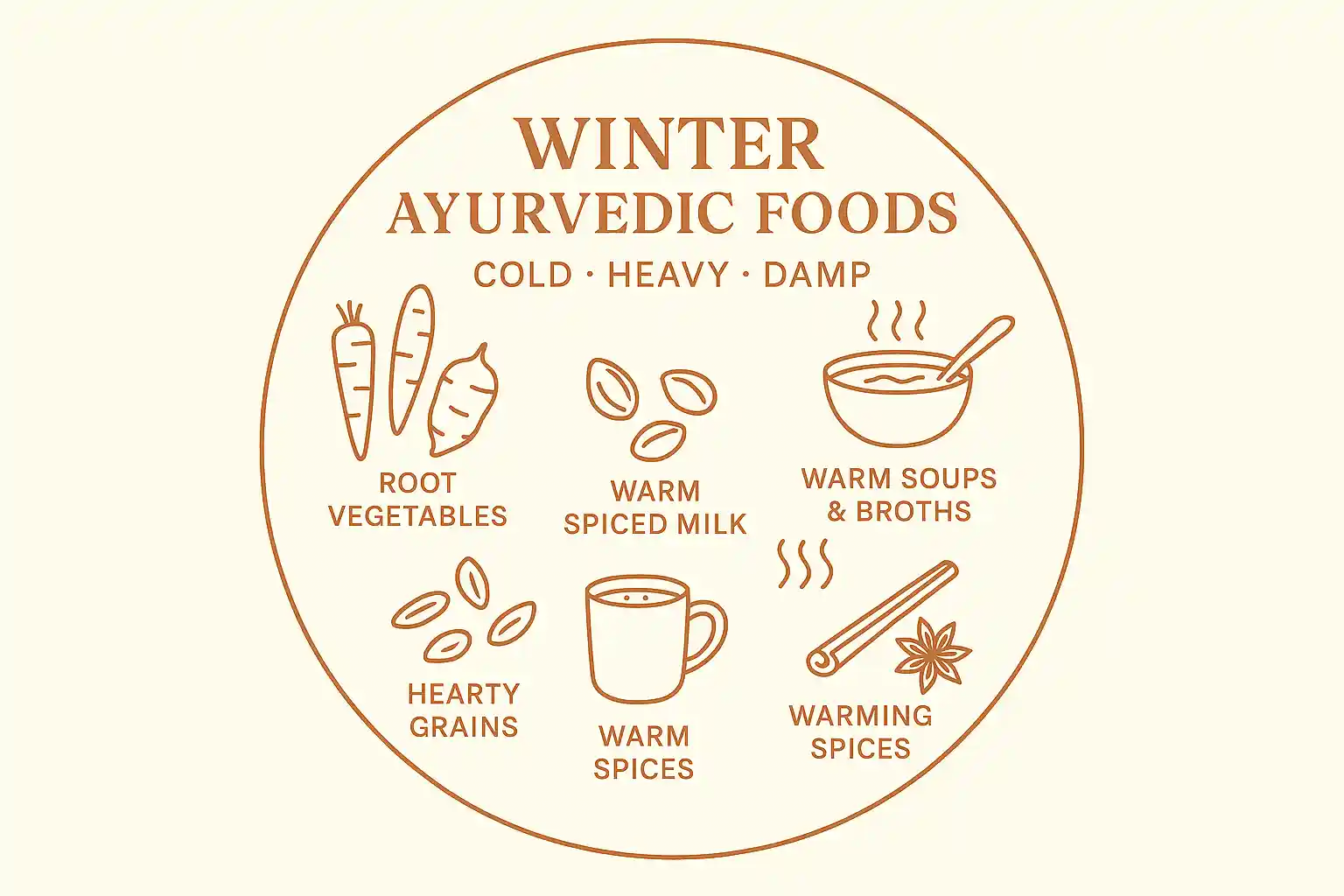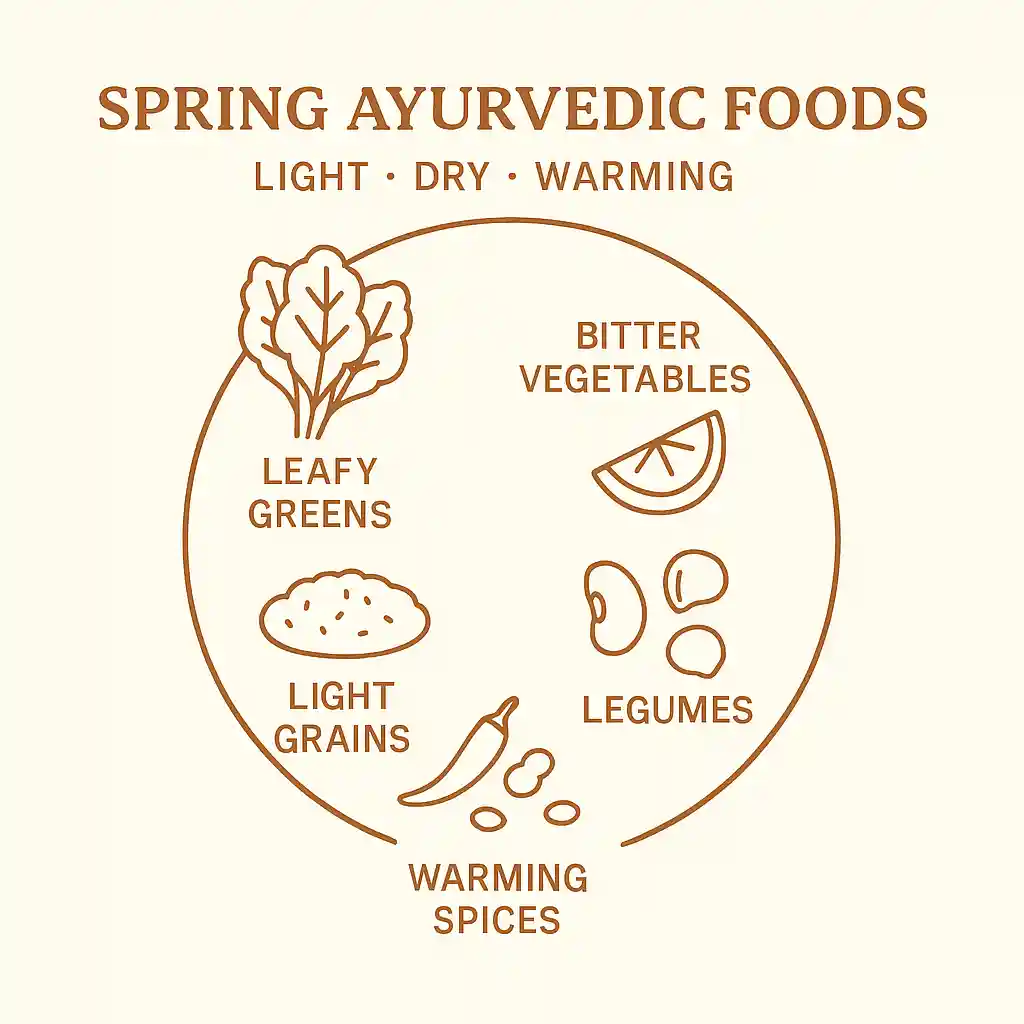As autumn arrives with cool winds and crisp air, Vata dosha begins to rise. Learn how to ground your energy, nourish your body, and stay balanced with Ayurvedic dietary guidance for the fall season.
Understanding Fall in Ayurveda: Late Sharad to Early Hemanta
In the classical Ayurvedic seasonal calendar (Ritucharya), fall spans late Sharad Ritu (autumn) through early Hemanta Ritu (early winter)—roughly from mid-October to early December in most temperate climates.
Sharad Ritu begins as a Pitta-predominant season, but as heat wanes and dryness sets in, Vata dosha begins to accumulate.
By early Hemanta, Vata dominates fully, bringing cool, dry, light, and mobile qualities that can disturb the body's balance—especially for Vata-prone individuals.
Signs of Vata Aggravation in Fall:
- Dry skin, lips, or hair
- Constipation or gas
- Cold hands and feet
- Restlessness, anxiety, or insomnia
- Racing thoughts or irregular appetite
Fall marks a seasonal shift from intensity (Pitta) to instability (Vata). It's a time to anchor and insulate—laying the foundation for winter resilience.
Ayurvedic Principles for Eating in Fall
To pacify Vata, favor foods and routines that are:
- Warm and moist (counter dryness)
- Hearty and grounding (counter lightness and mobility)
- Oily and nourishing (rebuild tissues and support Ojas)
- Consistent and rhythmic (reduce mental and physical instability)
Favor
- Cooked, soupy, oily meals
- Naturally sweet, sour, and salty tastes
- Root vegetables, grains, and stews
Avoid
- Raw, dry, cold, or rough foods
- Bitter or astringent foods in excess
- Skipping meals or erratic eating
Key principle: Ground and nourish. Your body needs insulation and regularity to stay balanced in fall.
Best Foods to Favor in Fall
Vegetables
- Root vegetables: sweet potatoes, carrots, beets, parsnips
- Squash: butternut, kabocha, pumpkin
- Cooked leafy greens: spinach, chard, collards
- Zucchini, green beans, asparagus
Fruits (cooked or stewed)
- Apples, pears, berries
- Bananas, grapes
- Pomegranates (in moderation)
Grains
- Oats (well-cooked)
- Basmati rice
- Quinoa, amaranth, barley
Healthy Oils
- Ghee
- Sesame oil
- Olive oil
Spices
- Ginger, cinnamon, nutmeg
- Cardamom, cumin, fennel
- Cloves, ajwain
Beverages
- Warm water
- Herbal teas (ginger, cinnamon, fennel)
- Warm milk with cardamom and nutmeg
Foods to Reduce or Avoid in Fall
Fall's dry, cool nature means that foods with similar qualities can aggravate Vata. For comprehensive guidance, see our detailed guide on foods to avoid for Vata dosha:
- Raw vegetables and cold salads
- Iced drinks and smoothies
- Dry snacks (crackers, popcorn, granola)
- Light grains (millet, puffed rice)
- Excess bitter greens (raw kale, arugula)
- Overconsumption of caffeine
Sample Fall Meals
Breakfast
- Spiced oatmeal with stewed apples and ghee
- Warm rice pudding with cardamom
Lunch
- Root vegetable stew with basmati rice
- Kitchari with warming spices
Dinner
- Moong dal with ghee and cumin
- Quinoa with roasted squash and sautéed greens
Throughout the Day:
- Ginger-cinnamon tea
- Warm lemon water
- Spiced milk before bed
Personalizing Fall Eating by Dosha
Vata-Predominant Individuals
- Follow fall guidelines strictly
- Emphasize warmth, oils, routine meals, and early bedtimes
Pitta-Predominant Individuals
- Favor warmth and moisture
- Use spices moderately to avoid Pitta aggravation
Kapha-Predominant Individuals
- Tolerate slightly lighter meals
- Use warming, stimulating spices to maintain digestive fire (Agni)
Experiencing Vata Imbalance?
If you're noticing signs like dryness, restlessness, insomnia, or bloating, your Vata may be elevated. Fall is the time to reestablish warmth, rhythm, and nourishment.
Preparing for the Deeper Cold: Fall as the Foundation
Fall's dietary support lays the groundwork for winter's endurance. By pacifying Vata now, you build Ojas—the subtle essence of immunity and vitality—so your body is ready for the colder, heavier demands of late Hemanta and Shishira Ritu.
FAQ: Ayurvedic Eating in Fall
Related Articles

Ayurvedic Diet for Winter (Vata + Kapha Season)
Winter brings cold, heaviness, and stillness—qualities that challenge both Vata and Kapha doshas. An Ayurvedic winter diet helps you build strength, stimulate digestion, and fortify your immunity during this introspective season.
8 min read
Ayurvedic Diet for Spring (Kapha Season)
Spring marks a season of renewal and growth, but in Ayurvedic terms, it's also the Kapha season. Learn how to align your diet with spring's energy for optimal vitality and balance.
7 min read